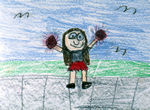
Children start learning even before they are born. No wonder parents are called children's first teachers! Parents make a powerful difference in what children learn and how they think – so spark your kids’ creativity by encouraging their curiosity, using common everyday experiences to inspire new ideas, building their confidence and using their art to spark conversations.
Encourage their curiosity. Ask questions.
Kids are naturally curious. Children know instinctively to ask questions. Children often ask better questions than adults. Listen and build on their curiosity. Continue to inspire their imagination with simple questions, while encouraging them to think of the answers or solutions. Ask your child to imagine and wonder, “What it?” “What if you could have a dinosaur as a pet?” “What if we took a vacation on another planet?”
Weave creativity into common everyday experiences.
Creativity can happen anywhere. Use common everyday experiences on teach creativity – in the car, on a walk or when you’re cooking together. Bring crayons and paper along when you go out to eat. Encourage your children to draw a story about a restaurant on Mars and share it while you’re waiting.
Build their confidence
When children are encouraged to look at things in many ways and believe in their ideas, it gives them the confidence to express what they’re thinking. Encourage your children to take the lead in coming up with new ideas. If they ask you to “make it for them,” reply that you’d love to see what they create. Children’s fresh and unique styles should be valued. Use any moment as a teachable opportunity to stretch your child’s thinking and encourage their creative expression. Support your child’s interests. Stretch what they know or know how to do.
Art sparks communication
Art helps children communicate their ideas. Children’s drawings are their first written communication years before they can read or write. Art opens the window into what your children are thinking and feeling. Talk about what you observe in your children’s art as they draw and paint. Let your child tell you the story of their art. “Tell me about your drawing?” is a perfect question to spark conversation.
You can also help your children become creative, confident, and competent learners by...
Setting the Stage
- Provide art materials and art projects
- Set up an Art Center in your home
- Talk with your kids about their art
- Encourage kids to be problem solvers
Speaking to Young Artists
Talk with children about art. The art they are creating and the art all around them. Notice the way art is used in everyday life.
Art all around us.
Ask kids how design affects the:
- homes we live in
- cars we drive
- clothes we wear
- books we read
- movies we watch...
...and our appreciation for the awesome natural beauty found everywhere!
Introduce art vocabulary to children. Look for lines, shapes/forms, colors, textures, patterns, repetition, and balance. Share opinions and what personal preferences are based on. Urge children to consider ways they could change the design of man-made items. Look for lessons from nature that could improve human designed items.
"Look what I made!"
When children say, "Look what I made!" show your interest. Encourage them to describe how they created their art. Children are eager to show adults their creations. How can you respond so they are motivated to explore the arts further?
- Remember to reflect their enthusiasm.
- Take their work seriously!
- Encourage children to be confident about their art.
- Inspire them to improve their skills with practice.
- Encourage them to try new ideas and different approaches.
- Their imaginations will soar. Positive, encouraging responses will help artists of all ages feel they are creative thinkers and capable doers. Usually just one positive comment or open-ended question will open up a fascinating conversation!
Trying these great conversation starters!
Here are some great "discussion starters" that will encourage children to open up. Try some of these statements and questions and get that conversation going!
Show appreciation:
"Thank you for showing me your creation." "I'm so glad you want to share your art with me."
Demonstrate genuine enthusiasm:
"What an imaginative idea!" "You're starting to use colored pencils in a different way than before!"
Describe what you see (artistic qualities):
"It looks like you used lots of red here, and a little blue in the bottom corner." "The lines you drew move all around the page." "This reminds me of (another artist's style or a child's earlier work)." Especially with young children, avoid asking "What is it?" Their creation may be an experiment in pattern or color, and not a picture of the family dog!
Ask how the child achieved an artistic effect:
"I'm wondering how you got these little pieces of clay to stick out like that." "Please explain to me what you did."
Dig a little deeper:
"Tell me more about what you've done." "I'm curious how you got this idea."
Comment on how the child worked:
"I saw you concentrating on your painting." "You had a smile on your face the whole time you were drawing!"
Sometimes, suggest extensions (after showing support and hearing the child's explanations):
"I wonder what would happen if you tried..."
An encouraging adult can make a world of difference. Support your children's innate desire to learn and to express ideas. Be a mentor and a role model. Help children develop to their full potential.